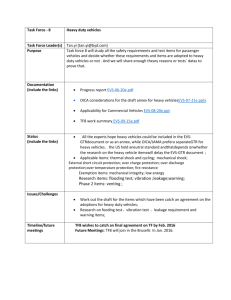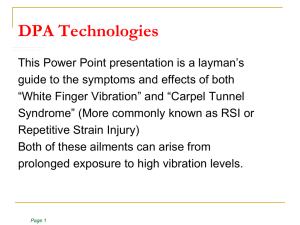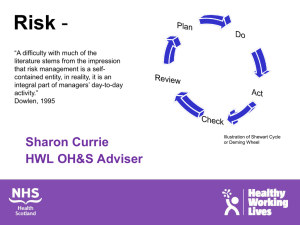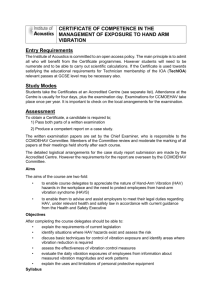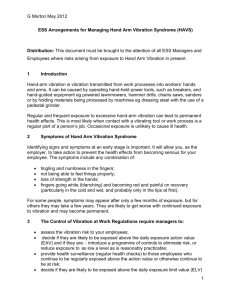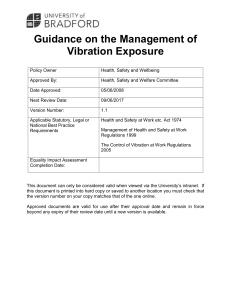Whole Body Vibration
advertisement
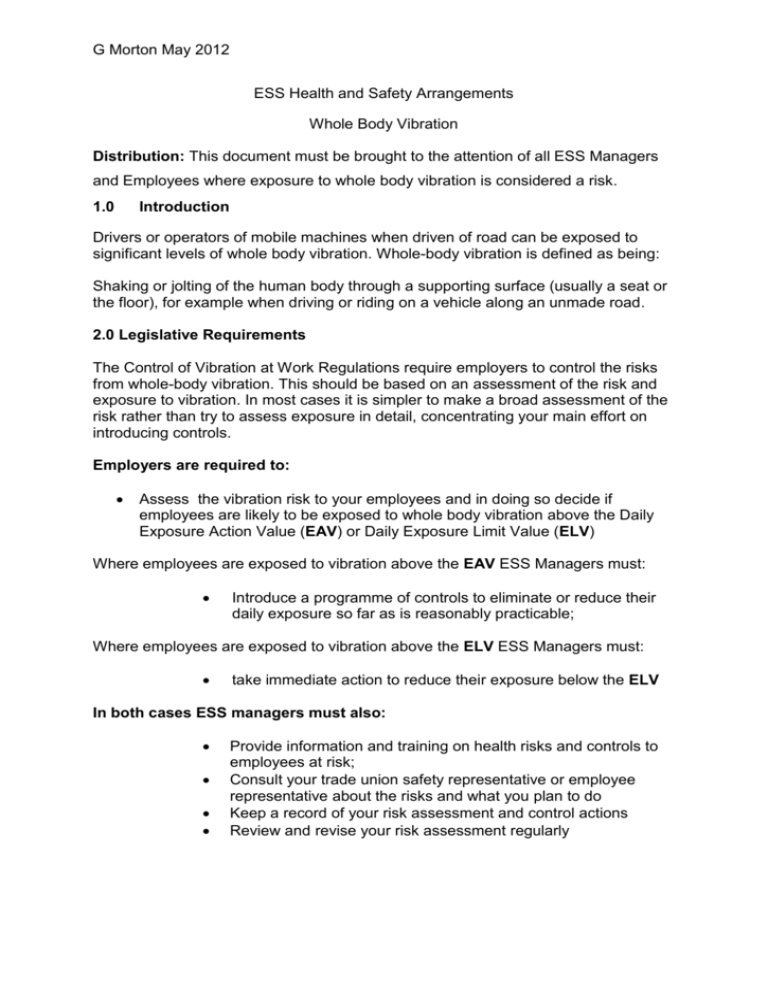
G Morton May 2012 ESS Health and Safety Arrangements Whole Body Vibration Distribution: This document must be brought to the attention of all ESS Managers and Employees where exposure to whole body vibration is considered a risk. 1.0 Introduction Drivers or operators of mobile machines when driven of road can be exposed to significant levels of whole body vibration. Whole-body vibration is defined as being: Shaking or jolting of the human body through a supporting surface (usually a seat or the floor), for example when driving or riding on a vehicle along an unmade road. 2.0 Legislative Requirements The Control of Vibration at Work Regulations require employers to control the risks from whole-body vibration. This should be based on an assessment of the risk and exposure to vibration. In most cases it is simpler to make a broad assessment of the risk rather than try to assess exposure in detail, concentrating your main effort on introducing controls. Employers are required to: Assess the vibration risk to your employees and in doing so decide if employees are likely to be exposed to whole body vibration above the Daily Exposure Action Value (EAV) or Daily Exposure Limit Value (ELV) Where employees are exposed to vibration above the EAV ESS Managers must: Introduce a programme of controls to eliminate or reduce their daily exposure so far as is reasonably practicable; Where employees are exposed to vibration above the ELV ESS Managers must: take immediate action to reduce their exposure below the ELV In both cases ESS managers must also: Provide information and training on health risks and controls to employees at risk; Consult your trade union safety representative or employee representative about the risks and what you plan to do Keep a record of your risk assessment and control actions Review and revise your risk assessment regularly G Morton May 2012 3.0 Assessing the risk ESS Manager must assess the risk of exposure to whole body vibration taking into consideration the following factors: machine or vehicle manufacturers warnings the machines or vehicles you are using are unsuitable for the tasks for which they are being used (check the handbook or ask the supplier) operators and drivers using poor techniques, eg driving too fast or operating the machine too aggressively driving high risk mobile machines for several hours a day, high risk mobile machines. The list of vehicles below are known to have high vibration exposures construction vehicles (mining etc) earthmoving vehicles (dumpers etc) tractors when used in transportation, primary cultivation or primary mowing etc driving vehicles on roadways or surfaces that are potholed, cracked or covered in rubble regularly driving road-going vehicles off-road or over poorlypaved surfaces for which they are not designed ESS Managers will also take into consideration any reports received from drivers about back pain or other musculoskeletal disorders likely to be associated to driving. 4.0 Measuring Exposure It is not necessary for managers to accurately measure vibration outputs using electronic measuring equipment. 5.0 HSE Advice on Approach to Assessment of Exposure The HSE advise managers to concentrate efforts on controlling exposure to whole body vibration over assessment and measurement 6.0 The Assessment ESS Managers will use an informed broad based risk assessment to identify high risk tasks/activities within their service before going on to develop and implement measures to control the risk. G Morton May 2012 7.0 Controlling the risk of exposure to whole body vibration Suitability of equipment for task: Managers will ensure equipment is in a good state of repair and suitable for the task intended. Purchasing policy: Managers must consider vibration information/warnings in manufacturer’s information when procuring new equipment. Maintenance of equipment: Equipment must be maintained according to manufacturer’s instructions, for the purpose of managing the risk of exposure to whole body vibration particular attention will be paid to: seat inspections, tyre pressures and suspension Maintenance of roads and surfaces: roads and ‘other’ surfaces will be inspected on an ongoing basis by users and Maintenance Officers, any deterioration in roads or surfaces will be reported as a defect to Customer Services/the Grounds Maintenance Team, remedial action will then be taken as necessary. Driver training, instruction and information: Driver’s licenses to drive vehicles will be checked before being allowed to drive vehicles and then annually thereafter. Drivers will be provided with necessary training and familiarisation training for the vehicle being driven. Drivers will be provided with a copy of the HSE’s Driving Away Bad Backs. Health Surveillance: Managers will encourage drivers to report back pain and other musculoskeletal conditions thought to be attributed to the vehicles they drive. Managers will refer employees to the Univeristy’s Occupational Health Dept as necessary. Note: it is important to take into consideration other duties/activities employees may be required to carry out. Driver training, instruction and information: Driver’s licenses to drive vehicles will be checked before being allowed to drive vehicles and then annually therefater. Drivers will be provided with necessary training and familiarisation training for the vehicle being driven. A record of license check must be maintained.

